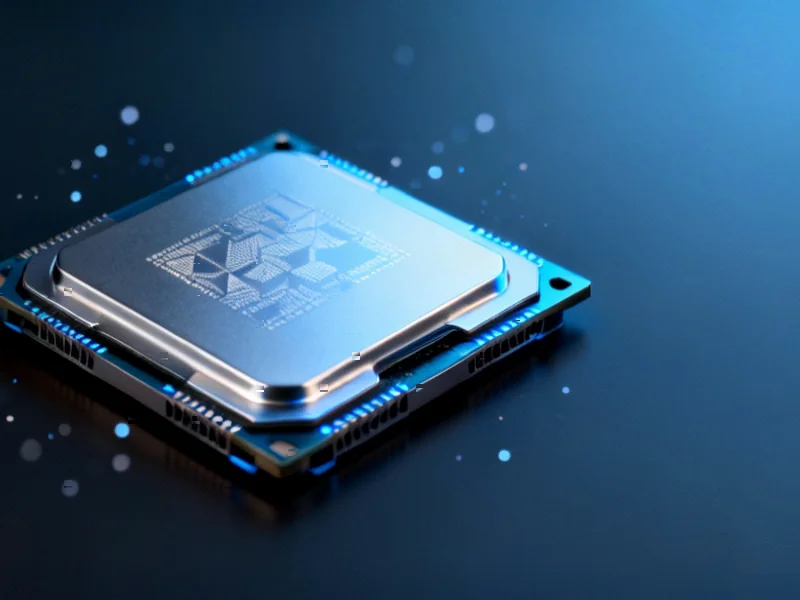According to The How-To Geek, AMD has officially confirmed its Zen 6 “Medusa” consumer CPU family at the Open Compute Project Global Summit. The processors will feature up to 24 cores achieved through two 12-core chiplets, a significant increase from current 8-core chiplets, alongside a 50% L3 cache boost from 32MB to 48MB per CCD. The company also announced it will replace its proprietary AGESA firmware with open-source “openSIL” firmware, which will debut on 2026 EPYC “Venice” server chips before arriving on Zen 6 Ryzen processors in early 2027. This official confirmation validates long-standing leaks and provides concrete timelines for AMD’s next-generation architecture.
Table of Contents
The Core Density Revolution
AMD’s move to 12-core chiplets represents a fundamental shift in chiplet architecture strategy that could reshape the entire processor market. While Intel has struggled with its tile-based approaches, AMD’s consistent refinement of its chiplet methodology is paying dividends. The transition from 8-core to 12-core chiplets isn’t just about adding more cores—it requires rethinking interconnect bandwidth, power delivery, and thermal management across the entire package. This density improvement suggests AMD has solved significant engineering challenges related to cross-CCD latency and memory controller efficiency that have historically limited chiplet scaling.
Beyond Cache Size: The Performance Calculus
The 50% L3 cache increase to 48MB per chiplet deserves deeper technical analysis than simply “more cache equals better performance.” In modern Zen architecture, L3 cache serves as critical shared memory between cores, and this expansion likely accompanies architectural changes to cache partitioning and prefetching algorithms. What’s particularly interesting is how this affects AMD’s 3D V-Cache strategy—with larger base L3 cache, future 3D V-Cache variants could potentially stack even more cache or might focus on different performance optimizations. The cache-to-core ratio improvement could significantly benefit memory-bound workloads without requiring the premium pricing of 3D V-Cache models.
OpenSIL: The Silent Revolution in Firmware
AMD’s transition from AGESA to openSIL represents one of the most significant but underappreciated announcements in recent processor history. While consumers focus on core counts and clock speeds, firmware has become increasingly critical for security, performance tuning, and platform longevity. Open-source firmware means security researchers can audit the code, motherboard manufacturers can implement deeper customizations, and the entire ecosystem can innovate more rapidly. However, this transition carries substantial risk—firmware vulnerabilities in open-source code could be more easily discovered and exploited if not properly managed. The enterprise-first rollout on EPYC “Venice” servers makes strategic sense, allowing enterprise-grade testing before consumer deployment.
Redefining the 2027 CPU Battlefield
With a confirmed early 2027 timeline, AMD is signaling confidence in its Zen architecture roadmap while putting pressure on competitors. Intel’s response to this announcement will be telling—whether they accelerate their own tile-based architectures or pursue different competitive strategies. The timing also suggests AMD expects Zen 5 to maintain competitiveness throughout 2026, reducing pressure for an interim refresh. What’s missing from the announcement is any mention of AI acceleration enhancements, which have become critical in both consumer and server markets. This could indicate that AMD is holding AI-specific announcements for later or may be developing separate AI accelerator strategies.
The Engineering Hurdles Ahead
While the specifications are impressive, the transition to 12-core chiplets and open-source firmware presents substantial engineering challenges. Thermal density becomes increasingly problematic with more cores packed into the same physical space, requiring innovations in packaging and cooling solutions. The openSIL transition, while beneficial long-term, could create compatibility issues during the transition period, particularly for motherboard manufacturers accustomed to AGESA. AMD’s decision to test openSIL first in server environments is wise, as enterprise customers typically have more controlled deployment processes and dedicated IT resources to manage firmware transitions.
What Zen 6 Means for PC Enthusiasts
For consumers, the Zen 6 “Medusa” announcement sets clear expectations for the 2027 upgrade cycle. The core count increase positions AMD to compete more aggressively in content creation and workstation markets where core count still drives purchasing decisions. However, the real story may be in the platform features that accompany these processors—DDR6 memory support, PCIe 6.0, and potentially new socket requirements. The codename “Medusa” itself suggests AMD views this as a transformative architecture that could “freeze” competitors in their tracks, much like the mythological figure turned onlookers to stone.
Related Articles You May Find Interesting
- Intel’s $5B AI Gambit: Why SambaNova Could Transform Chip Wars
- Apple’s Siri Overhaul Faces Critical Test in 2026 AI Race
- Quantum Computing’s Miniaturization Revolution
- Apple’s $2.5 Billion Tariff Toll Reveals Deeper Supply Chain Challenges
- Applied Compute Raises $80M to Build Company-Specific AI Agents



